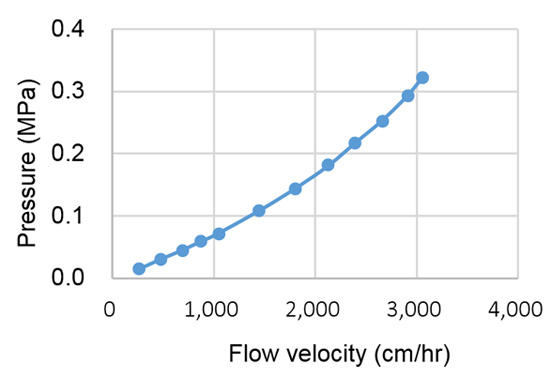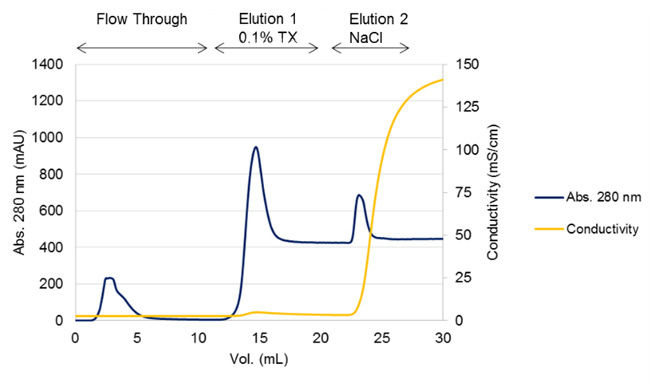CellufineTM MAX AminoButyl
Cellufine™ MAX AminoButyl is developed mainly for concentration of molecules having strong hydrophobicity such as VLPs (virus like particles). Cellufine MAX AminoButyl is designed on the basis of optimized Cellufine MAX Butyl to improve recovery of target molecules.
Ligand structure of Cellufine MAX AminoButyl is described in Figure 1.

Specification and characteristics of Cellufine MAX AminoButyl is described in Table 1 and 2.
| Item | |
|---|---|
| N contents (μmol/ml) | 20 - 33 |
| Elution volume (ml) α-chymotrypsinogen A (HIC mode) Pepsin (IEX mode) |
12.0 - 17.0 12.0 - 17.0 |
| Microscopic test (%) | < 5 |
Table 1Specification of Cellufine MAX AminoButyl
| Matrix | Highly cross-linked cellulose |
|---|---|
| Particle size | 90μm (40 – 130 μm) |
| Ligand | Butyl + primary Amine |
| Protein adsorption (1) in 2M (NH4)2SO4 | α-Chymotripsinogen A; + Ribonuclease A; - Lysozyme; - |
| Protein adsorption (2) in 20 mM Tris-HCl (pH7.5) | Transferrin; - BSA; + Pepsin; + |
+; adsorption, -; no adsorption
Table 2Characteristics of Cellufine MAX AminoButyl
As base matrix is highly cross-linked cellulose particles, Cellufine MAX AminoButyl show superior flow property like figure 2.

(Condition; Column; 2.2 cm ID x 20 cm, Mobile phase; Pure water (24±1℃)
Application of Cellufine™ MAX AminoButyl
Purification of r-HBsAg (recombinant Hepatitis B surface antigen) VLPs from yeast with Cellufine AminoButyl
Partial purified r-HBsAg VLPs solution was loaded on packed Cellufine MAX AminoButyl column (16 mm I.D. x 500 mm H) and then column was washed by 20 mM phosphate buffer (pH 7.0) sufficiently. At first, phosphate buffer (pH 7.0) containing 0.1 % Triton X was used as elution solution (Elution 1). And then molecules was eluted by 2 M NaCl (Elution 2). Each fraction was recovered and analyzed.
The figure below showed a chromatogram of purification of r-HBsAg VLPs with Cellufine AminoButyl. r-HBsAg VLPs was detected by ELISA assay.

| VLP | Protein | |||
|---|---|---|---|---|
| nU | % | ug | % | |
| Load | 4,260 | 100 | 2,320 | 100 |
| Flow through | 480 | 11 | 350 | 13 |
| Elution 1 | 2,060 | 48 | 770 | 30 |
| Elution 2 | 172 | 4 | 1,190 | 46 |
Table below showed the results in this test.
Most r-HBsAg was obtained in elution 1. Results of protein assay in fraction suggested further purified r-HBsAg was concentrated by detergent elution. The results suggested Cellufine MAX AminoButyl is useful to purify VLPs.
Chemical Stability and Cleaning-In-Place
Cellulose is well-known as a natural product having chemical and physical stability. Thus, since Cellufine is derived from cellulose, it also is stable to chemicals and caustic and acidic solutions. CIP of all Cellufine media can be carried out with 0.5 M NaOH solution. Used media should be stored in 20 % ethanol at 2-25 ℃ after cleaning.
